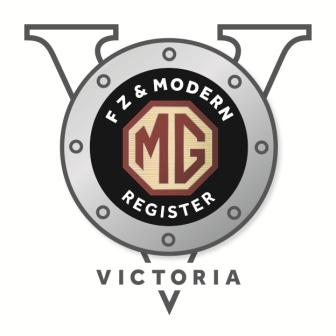 MGF & MGZ-RST Register
MGF & MGZ-RST Register
by Jeff
Turnbull, January, 2010
No
one needs reminding of the presence of the MG badge or the drawing power of
that name throughout motoring history, but there were times when the marque was
seemingly doomed, only to rise Phoenix-like from the ashes and re-establish
itself as a predominant sports car. For that is what we primarily associate MG
with, two-seat roadsters. The top-down driving experience was what initially
gave MG its reputation and appeal. This is despite releases of MG four-door
sedans throughout the years such as the Pre-War SA, WA and VA saloons and the
Magnette, launched in 1953. They even produced a station wagon, the ZT-T Sportswagon,
introduced in 2001.
Yet in 1980, (23 October to be exact!) when the last MGB rolled off the
assembly line at Abingdon, it seemed like curtains for the seminal MG. With
nothing really on the horizon for British Leyland it looked like the end of the
line – potentially: R.I.P. MG, 1924 to1980. Yet all was not quite over. In the
years that followed the demise of the ‘B’, there was still
a decisive pulse that could be detected.
Early days yet – 1980 to 1995.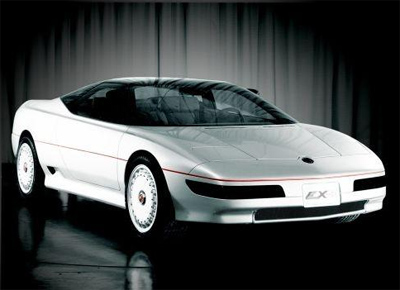
In the last few months of 1984, Austin Rover
(as the company was styled then) decided to go all out in producing a prototype
for a new MG sports car with ambitious plans for its future. The EX-E as it was known was a massive step forward, but
would it go into production? It looked like a remarkably exciting sports car –
certainly in the MG tradition. Construction techniques and aero-dynamic
packaging stood out. The cabin’s red LED display was spectacular. But… and it was a big but… was Austin Rover
going to commit the MG EX-E to production?
Completed under the design team headed up by
Roy Axe, the MG EX-E debuted at the Frankfurt Motor Show in September, 1985 to
high acclaim. But … it went no further. The notion of a lightweight car was
fine for a concept car but, so the company concluded, it would prove very
expensive to employ this in a production car. The end result: the EX-E remained
just what it was – a concept car.
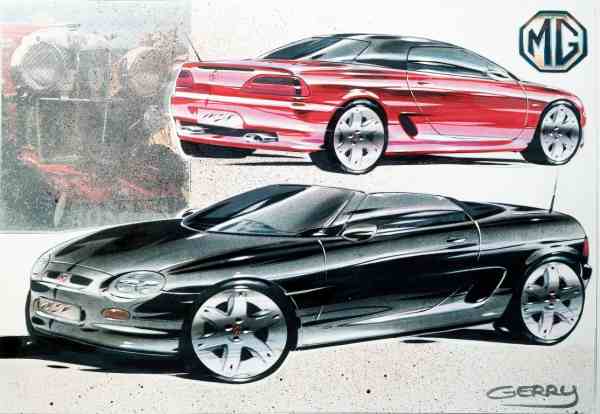
Yet all was not lost completely. Chief
designer Gerry McGovern, who had designed the body shell of the EX-E, had
another trick up his sleeve. He was buoyed by the belief within the management
of Austin Rover that the MG marque, having established such a spectacular
reputation over its lifetime, should not be allowed to perish forever and that indeed,
the name could actually be exploited. And why not? The demand for the sportscar
as a road vehicle all over the world had not declined over the years.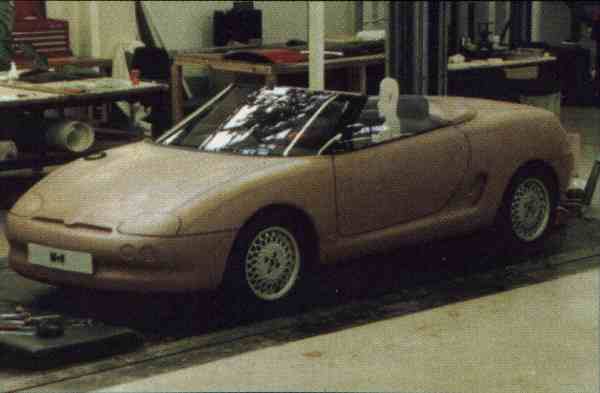
Progress between 1985 and 1989 on a
MG-badged, two-seater, front engined, front wheel drive car continued with the F-16; if only as a side-line project. Yet, it was a
serious, potential replacement for the defunct MGB. If one views the various
PR1, PR2 and PR3 prototypes, it can immediately create the illusion (with eyes
half closed) that finally, here is the MG F of
1995, in its earliest form.
But in 1989, fate didn’t smile kindly on the F-16 as it hadn’t on the
EX-E, four years before. This time, there were serious doubts about the
company’s overall finances; its viability as the decade drew to a close was in
question. The government was keen to offload the company to private enterprise
and adding to the general disenchantment, the release of the company’s sedans
hadn’t exactly set the world on fire. Therefore the F-16 was not considered a
priority by management and this project didn’t progress beyond mock-up stage.
Indeed, if only briefly, the MG roadster was
in showrooms again in 1992 when the MG
RV8 was launched – the first production
MG since 1980. In essence, this powerful car was a re-styled ‘B’ yet it was certainly
in the classic MG mold, even using the old MGB body shell with new body panels
and a Rover 3.9 V8 engine. Yes, it was a MG although it did use as many Rover ‘in
house’ products as could possibly be sourced. Though it was always a stop-gap
measure, it was designed to keep the MG name ‘out there’ until something more
innovative came along.
A New breed – Rover’s MG F – 1995 to 2002.
But was there any chance that something brand new and exciting was
waiting in the wings somewhere? Rover had created its Rover Special Products
Division, (the RV8 was its first car) and all of a sudden, it seemed like this just
might be the saviour of the MG roadster project. This division was a research facility,
entrusted to take on those projects which were considered outside the
mainstream of motor vehicle design – much to Gerry McGovern’s delight.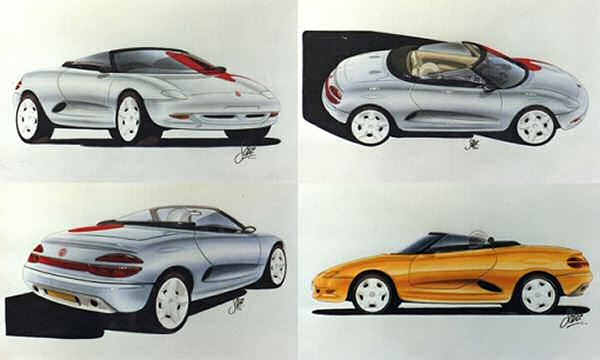
The PR3 layout was revived and designated
project ‘Phoenix Revival’; the MG F was truly starting to take shape when the
mid-engined concept was decided upon and initial sketches were made in January,
1991. Full size clay modeling commenced the following March and within a short
time, the prototype known as ‘the red car’ was shown to enthusiastic Rover
executives. Within months, the whole proposal was forwarded back to McGovern
and his team who worked to lower the windscreen height, and ‘tweak’ the flanks of
the car, re-shape the headlights and add a traditional-looking MG grill. Thankfully,
the idea of pop-up headlights was discarded.
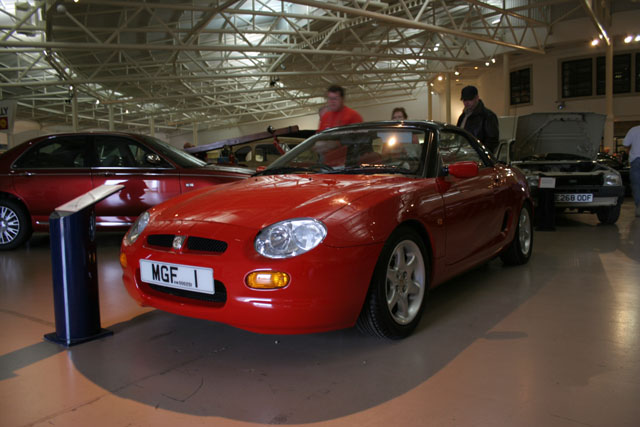
With
a few more changes, the MG F as we know it was truly born. This anticipated roadster finally emerged into the spotlight
at the Geneva Motor Show in 1995. From
the outset, the classical styling was noted, but was it a true-blue (or British
Racing Green for that matter) MG or just a re-badged Rover? Time would be the
judge of that debate.
As a major departure from former MG
technology and design – the mid-engined concept, using the tried and proven,
Rover K-Series engine as its powerplant was startling. Innovative also was the
Hydragas suspension which was invented by Dr Alex Moulton (who had worked
closely with Sir Alec Issigonis). The use of this type of suspension was a serious
gamble taken on by Rover. And may we say there was a new distinctive MG logo to
go with the new car – designed with a stable future in mind.
In all respects, this was an up-to-date,
mid-ninties styled sportscar with only the respected Mazda MX5 as its main
rival in the small roadster category in this country. It was sold in Melbourne from 1997 with the initial model (later unofficially
styled Mark I) on sale firstly, from Lance Dixon’s MG Garage in Richmond. Then, for a
short time Trivett Classic Group (Kellow-Falkiner) took on a dealership and
finally, Zagame became the only dealer in more recent years. Initially the
models sold for around $54,000. This price still positioned the MG F within range of the average sports car buyer,
but not reaching the heights of price-tag extravagance of the more exotic Porsche
or Lamborghini. Therefore, it remained true to the ideals of the MG –
affordable elegance.
The MG Fs major selling point, apart from the torquey, K-Series
engine, was the standard equipment which came with the two models – the 1.8mpi
and the VVC (Variable Valve Control). The standard engine gave 120/bhp at 5500rpm
and the VVC, 145bhp at 7000rpm. According to sales literature, the engine loved
to be revved at 7000rpm and beyond. The remote controlled central and dead
locking features were well received as were the electric windows and power
steering (initially on the VVC model only, but from 1998 in both versions).
There were variations in the interior – Fusion or Fusion/leather seats were
charcoal with green piping or red and various dash surrounds were available,
including imitation walnut woodgrain. Exterior finishes included the solid
colours; Flame Red and White Diamond; the Clearcoat metallic in British Racing
Green and Charcoal; and pearlescent in Amaranth and Volcano Red. A black hard
top was also available. For Australian conditions, the
first 1.8mpi models had dual airbags, Power Assisted Steering, ABS and air
conditioning as options, whereas on the VVC model, they were standard.
Yet,
it was impossible to please everyone. Critics noted the lack of leg room, particularly
for the taller driver with the left leg being pressed hard against the central
tunnel. Some noted that although power-assisted windows were provided,
adjustment of the drivers’ and passenger’ side mirrors (in 1997) was still to
be done by hand – why no power mirrors? And then there were the real problems! Foremost, as any
experienced MG F owner will tell you – the head
gasket in the earlier models was an unmitigated disaster! A replacement kit was
soon on the market as the standard head gaskets began to fail with monotonous
regularity. The Hydragas suspension needed (and still needs) to be re-gassed
about every 18 months, depending on usage. Whilst a really low ride height
might appear to be particularly sporty, it will cause excessive wear on the
tyres, if not adjusted regularly. The seats were
considered by some a little second-rate, lacking more precise adjustments.
On the positive side, safety was accentuated
with additional side frame and under floor strengthening. Remarkably, the
windscreen surround was designed to remain absolutely rigid and virtually
indestructible in the unfortunate event of a rollover. It often goes completely
unnoticed, but the front and rear tyres of the VVC were
of differing sizes on the 6 inch rims; the front tyres were 185/55 while the
rear tyres were the wider 205/50. Theoretically, this was to handle the extra power
of the engine.
There
were issues as well with the Cam belt and with
the rear plastic window on the soft-top which tended to crack under extremely
low temperatures when the roof was lowered. (A problem mainly for freezing European
winters but not as prominent a concern in Australia). However, in most
respects, the MG F seemed to deliver what the design team claimed was quite
simply, ‘The World’s Most Enjoyable Car To Drive.’ Take one around The Great
Ocean Road and you’ll see; it just loves the twisty bits!
Variations and Limited Editions were released from time to time in the
period up to 2002. The Abingdon (1998)
upgraded the standard MG F features with complete beige leather upholstery,
beige hood and 6-spoke 16 inch wheels as well as a few more interior chrome
refinements. In 2001, the Trophy 160
was released with a distinctive colour range – Solar Red, Anthracite, Trophy
Blue and the distinctive, Trophy Yellow being a major selling point. This last
colour could be matched by spectacular yellow interior, console, steering wheel
and door inserts (cards) – a bit ‘buttercuppy’ and not suited to all tastes. Not
to mention, there was a significantly re-tuned engine, new body package with
spoilers, stiffer suspension and MG red-coloured brake calipers on larger front
wheel disc brakes. In 1999, MG released the 75th Anniversary Edition
to celebrate that particular milestone in the MG progression.
For 2000 through to 2002, a Steptronic variable automatic transmission
was an optional extra, offering the standard auto or the option of ‘F-1’ style
paddle-operated levers, placed on the steering wheel. This automatic option was
available only on the 120bhp model due to differences in the power/transmission
match.
From 1999 to 2002, MG F became the MY (Model Year) models which grew to
be known (unofficially) as the Mark II. By this time, many of the old problems
from the teething years of 1995-7 had been eliminated – particularly the dodgy
head gasket. A newly-designed head gasket and cylinder head location was
introduced much to everyone’s relief! Apart from this requisite for change, the
cabin refinements were the major focus of the designers. There were improved
seats fitted to perk up comfort, a discreetly re-designed centre console and
the cream faces of the instruments with their MG logo were replaced, to the
disappointment of some drivers. The exterior of the windscreen surround now
appeared in the colour of the duco instead of black. Improvements were made to
the sound system which in 1995 had sported a cassette tape deck! Oh…and if you
have an early MG F,
you will recognize the slots inside the glove box to house your Boney-M and
Julio Iglasies cassette tapes – and little else! In the age of CDs, it could be
assumed that this too would disappear in the current TFs, but not so! Your cassette storage is
still there. Maybe it was just not cost effective to change the molds.
The re-vamped T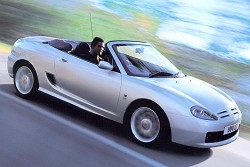 F – 2002 to 2005.
F – 2002 to 2005.
Remarkably,
there had been no attempt to completely redesign the body shape of the MG F – those
rear lights for the current TFs are
for all intents and purposes, identical to the first model which rolled out in
1995! When an updated roadster hit the showrooms from
February 2002, (a little later in Australia) it was marked out by its
slotted grille replacing the wire grille which had been there since day one.
Exterior changes were also noted with the fuller bumpers and different shaped
engine air intakes. The headlights became distinctively tear-shaped, protruding
more into the grille region. It was similar, but different!
Yet the engineering had changed for good.
Gone was the Hydragas suspension to be replaced by coil-over damper units and
the body was further strengthened. Interior styling tended to remind drivers of
the earlier MY models. Released were the TF 135
and TF 500 versions. Like its ‘Mark I’ predecessor, MG-Rover
introduced a number of specials over the three years of the TF’s production run – Sprint
SE (2002), Cool Blue SE (2003),
80th Anniversary Limited
Edition and the popular, Spark, both
in 2004. Cool Blue matched the
Trophy Blue exterior with a blue hood and Alcantra blue seats. There were also
Momo gear knobs and chrome optional packs available. The MY 2005 featured a
first for MGs – a heated glass rear window on the soft-top!
By
2004, it was clear that the MG-Rover company was in deep financial trouble.
Options were tried to keep Rover-MG afloat and with a huge injection of cash
into the company, it managed to struggle on for another year. Then once more, it
was – all over, red Rover (pun intended) – and consequently, time seemingly had
caught up with the MG - yet again.
Surely there was no return from the dead this time. No new MGs were to be sold
in Australian dealerships and showrooms from this point onwards.
Made
in China
– MG TF
– 2007 to 2010.
Then, in 2007 miraculously,
yet another lifeline materialised for the beloved MG roadster, ensuring the
name lives on a little longer into the future. In a previous deal, Chinese
company SAIC became the major stake-holder in a complicated deal through the
receivers of the original MG-Rover. This had involved previous Ford and BMW
interests in the old Rover company, which complicated matters somewhat.
It
is perhaps significant that the looming industrial giant of the twenty-first
century, China
should have a say in the future of the iconic MG brand, so … Chinese MG TFs??? Get
used to it!
After buying the bankrupt MG Rover for US$103m, the state-owned
Nanjing Automobile Company equipped out its huge, new factory in Nanjing which
is now capable of producing 200,000 cars, 250,000 engines and 100,000 gearboxes
annually. They produce the Roewe, (pronounced ‘Rongwei’ or is it ‘wrong way’?)
car here for their local market. All dies, tooling and equipment for MG had
been shipped over to China
from the old Longbridge plant which was then re-leased on a thirty year deal from
the receivers for just assembling the Chinese-made TFs. Yet, ironically, the build quality of the TF was reportedly better than the original
British-built cars. In
2007, General Manager Zhang Xin committed his company to keeping alive the
iconic British flavour of the TF and true to his word, his production run even
displayed the Union flag on the body.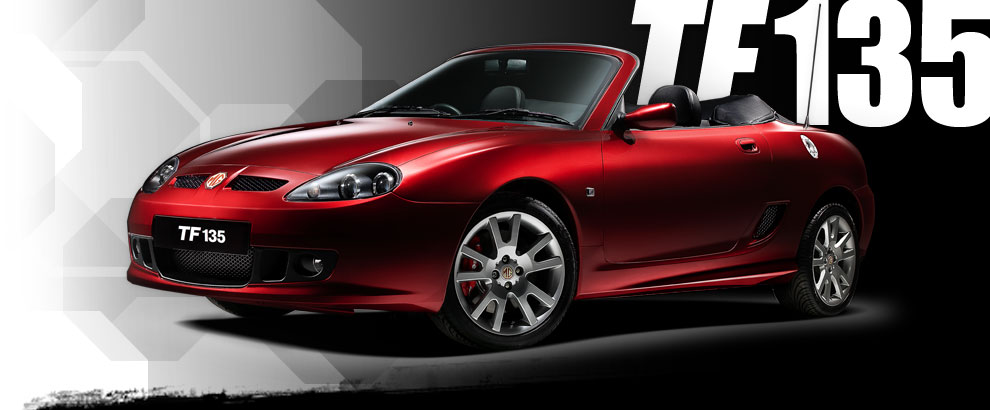
The 2008 TF refined
the body shape even further but kept the basic MG F design concept intact. Remarkably,
the grille reverted to close to the original wire mesh grille – something that
strongly links the current TF to
the original F.
Nanjing
declared – ‘Fun Is Back’ (Did it ever disappear?). Models include the TF 135, LE 500 and the 85th
Anniversary Edition; limited to just fifty models and sorry… all are sold! All
come in some spectacular colours; Radiant Red, Oceana Blue and Storm Grey are
outstanding. This car is powered by the N-Series engine; a derivative of the
tried and trusted K-Series. Originally launched in 2006, it took two years for
the car to arrive at showrooms because of the company changeover. The Limited Edition (LE 500) of only 500 cars is
identifiable by individual numbering. As SAIC owned the rights to the original
VVC engine, NAC could only build 135HP engines however, it is believed NAC
developed a non VVC 160+hp engine and this, in future may be offered as an
alternative to the 135 engines.
On 8th January 2009 NAC MG UK Ltd changed its
name to MG Motor UK Ltd to facilitate the image of the MG brand within the
parent company and strengthen the already recognizable name, which although it
means little or nothing within China itself, it is held in such high regard
elsewhere. In 2010, the production of the MG returns
to Britain with the old
Longbridge plant assembly lines ticking over once again and it would
seem that they have in mind a tilt at the lucrative U.S. market, given improved
economic circumstances. Many find it difficult to understand why Rover-MG never
committed to releasing the original F in America. And yes, the badge changed
subtly yet again.
Sadly though Australia
still seems to be a ‘no go’ zone for new MG sales. It
is unfortunate that at this point in time, no dealers in Australia let alone Melbourne, see the viability of entering into
a dealership to sell the new Chinese/British MGs. Even in the highly
competitive motor market, perhaps this will change in time and for the here and
now, the new MG TF lives on … but not downunder!
If there are errors, omissions or corrections which should
be made to this account, please let me know.
Sources:
Adcock, Ian, ‘Project
Phoenix: the Birth of the MGF’, Bloomsbury, London, 1996.
www.aronline.co.uk
www.austin-rover.co.uk/pr3storyf.htm
www.mgfregister.org/models
www.mgf.ultimatemg.com
www.mgtf.be
www.wikipedia.org/wiki/MG_F
Thanks to Andrew Regens.
Back to F, Z & Modern Register Home Page







 F – 2002 to 2005.
F – 2002 to 2005.